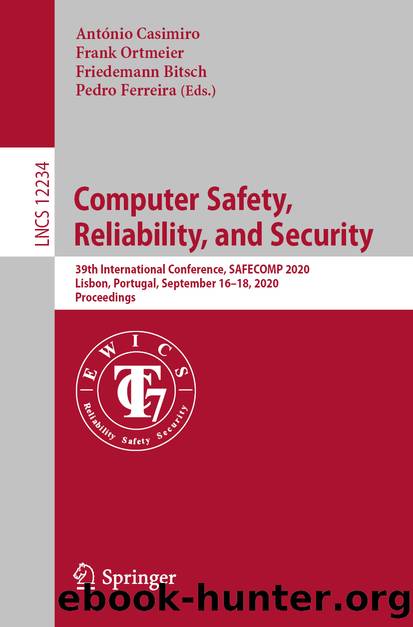Computer Safety, Reliability, and Security by Unknown

Author:Unknown
Language: eng
Format: epub
ISBN: 9783030545499
Publisher: Springer International Publishing
2 Model-Centered Assurance
If a world model is to be the focus for assurance, we need to consider the properties needed for safety, and the hazards to these. The intuitive property required of the model is fidelity to the real world, at least insofar as required to plan safe actions. In particular, if M is a model of world W, then any actions planned and shown to be safe using M should be safe when executed in W. The inverse need not be true; that is, there can be safe actions in the real world that do not appear so in the model. Thus, the model does not need to be a strictly accurate representation of the world: it can be conservative or, as we say, safely approximate.
In the absence of monitors, the model could be expressed in the variables of some latent space discovered by ML. But requirements for assurance monitors will surely be expressed in naturalistic terms (“don’t hit a pedestrian”) and the model must therefore represent these fairly directly. Hence, in model-centered assurance, the model must be a naturalistic one. Beyond that, the content of the model and submodels constructed by perception functions will be determined by the system and its purpose and goals. For a self-driving car, the overall model will represent something like an annotated map of its surroundings: it will include the layout of the local roads and junctions, information about nearby vehicles and pedestrians, locations of fixed objects (e.g., mailboxes), road signs and their interpretation, traffic signals, and so on. It is a design choice whether there is one model or a coordinated collection of submodels. A typical submodel is a list of detected objects in the vicinity of the ego vehicle, giving the location, size, velocity, type, and inferred intent of each; another might be an occupancy grid (a discretized probabilistic 2D map, describing the occupancy of each “square”); and another might be a representation of traffic lanes. Inputs from many different sensors (e.g., GPS location and map data, odometry, lidar, radar, proximity sensors, cameras etc.) will be interpreted and fused to create the world model and its submodels. All of these data sources present challenges in interpretation but we will focus on image data from cameras since this is the most widely studied and discussed, and among the most challenging.
Lin and colleagues [6] outline a representative vision processing pipeline for a self-driving car: image data from the cameras are fed in parallel to an object detector and a localizer; the object detector discovers the objects of interest around the vehicle, such as other vehicles, pedestrians, and traffic signals; the detected objects are then passed to an object tracker that associates objects with their past movements and predicts the future trajectories of moving objects [7]; in parallel, the localizer determines the location of the ego vehicle. Subsequently, the object movement information from the object tracker and vehicle location information from the localizer are combined and projected onto the same 2 or 3 dimensional coordinate space by a sensor fusion engine to create the model used by the action functions.
Download
This site does not store any files on its server. We only index and link to content provided by other sites. Please contact the content providers to delete copyright contents if any and email us, we'll remove relevant links or contents immediately.
Applied Cryptography and Network Security by Unknown(1641)
Digital Forensics and Incident Response - Second Edition by Gerard Johansen(1502)
Network Security Strategies by Aditya Mukherjee(1407)
Modern Cryptography for Cybersecurity Professionals by Lisa Bock(1374)
Practical Cybersecurity Architecture by Diana Kelley Ed Moyle(1373)
Web Penetration Testing with Kali Linux - Third Edition by Gilberto Nájera-Gutiérrez(814)
Cybersecurity - Attack and Defense Strategies by Erdal Ozkaya & Yuri Diogenes(616)
Web Application Obfuscation by Mario Heiderich & Eduardo Alberto Vela Nava & Gareth Heyes & David Lindsay(612)
GCIH GIAC Certified Incident Handler All-in-One Exam Guide by Nick Mitropoulos(517)
Kali Linux Penetration Testing Bible by Gus Khawaja(463)
Cybercrime Investigations by John Bandler(457)
The Hardware Hacking Handbook by Colin O'Flynn(452)
Kali Linux: Testing Your Network: How to Test Infrastructure Security with Security Testing and Penetration Testing by Eltrinos Frank(392)
Computer Hacking Forensic Investigator Exam Workbook: 500+ Questions & Answers for ECCouncil 312-49: Updated 2020 by Aries+ Centre(388)
The Big User-Friendly Cyber Security Gaint - Palo Alto Networks: An Ultimate Guide To Secure Your Cloud And On-Premise Networks by Purackal Rachel Sebastian(366)
Security in Computing, 5e by Charles P. Pfleeger & Shari Lawrence Pfleeger & Jonathan Margulies(353)
Penetration Testing and Reverse Engineering: Intrusion Detection Systems and e-Commerce Websites by Rob Kowalski(346)
8 Steps to Better Security by Crawley Kim;(339)
Security, Privacy and User Interaction by Unknown(316)
